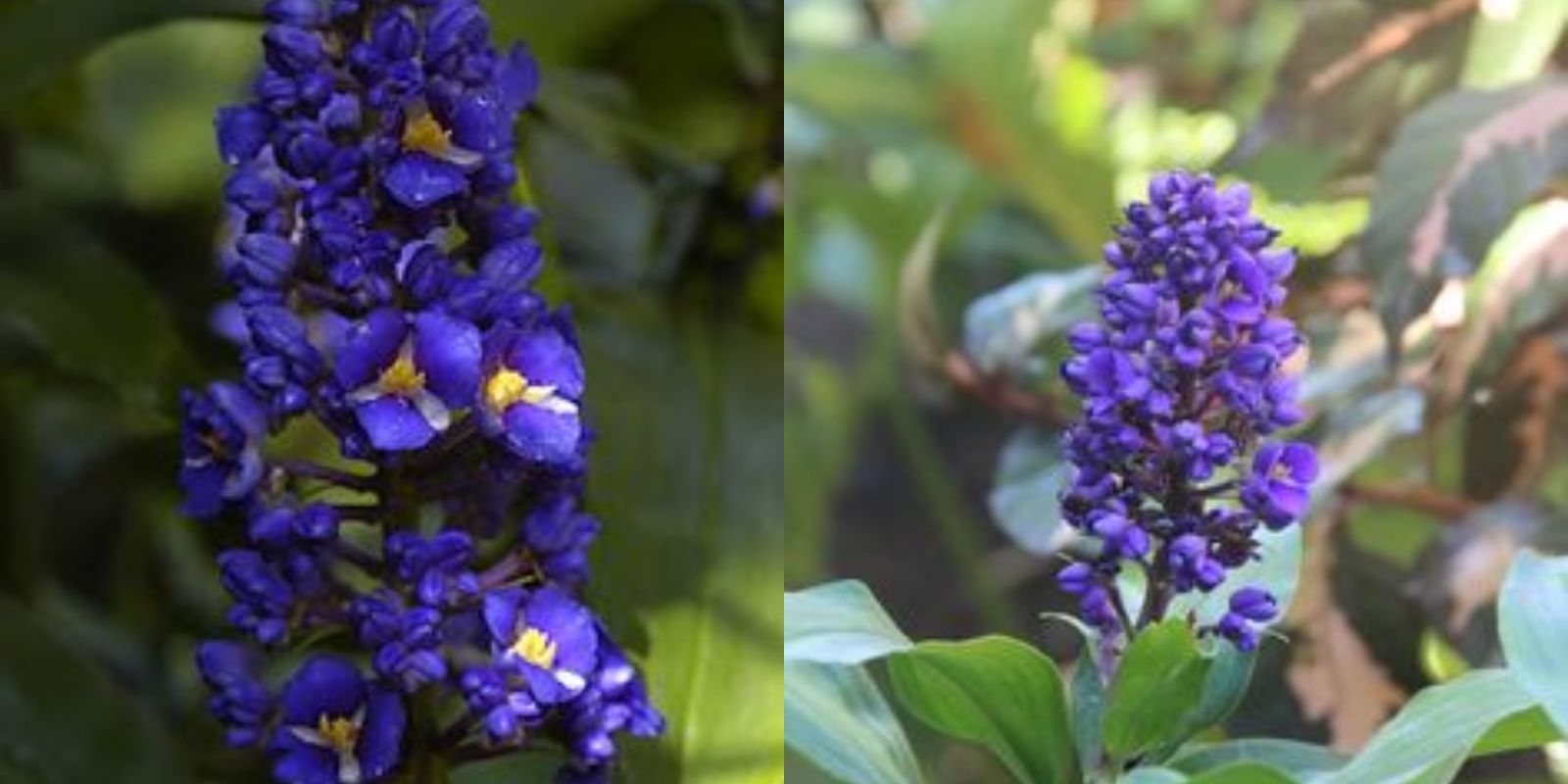Blue Ginger (Dichorisandra thyrsiflora) is a striking tropical plant known for its vibrant blue flowers and lush green foliage. Though commonly referred to as ginger, it is not a true ginger plant. This perennial species belongs to the Commelinaceae family and is native to Brazil. The plant’s stunning appearance and relatively easy care make it a favorite among gardeners and plant enthusiasts.
Characteristics and Appearance
Blue Ginger can reach heights of up to 5 feet (1.5 meters) and spreads about 3 feet (1 meter) wide. Its stems are erect and succulent, adorned with glossy, lance-shaped leaves that can grow up to 8 inches (20 centimeters) long. The most captivating feature of Blue Ginger is its rich blue flowers, which bloom in clusters atop the plant. Each flower is small, about 1 inch (2.5 centimeters) in diameter, but their intense color and the way they cluster together create a stunning visual display.
The plant typically blooms in late summer to early fall, providing a burst of color when many other garden plants are starting to fade. The flowers attract pollinators like bees and butterflies, adding to the plant’s appeal in a garden setting.
Growing Blue Ginger
Growing Blue Ginger can be a rewarding experience, whether you are an experienced gardener or a novice. Here are the steps to successfully cultivate this beautiful plant:
1. Choose the Right Location
Blue Ginger thrives in warm, humid environments and prefers partial to full shade. Too much direct sunlight can scorch its leaves and inhibit flowering. An ideal location would be under the canopy of taller trees or along the shaded side of a building.
2. Soil Preparation
This plant prefers rich, organic soil that is well-draining. Amend the planting area with compost or well-rotted manure to improve soil fertility and drainage. Blue Ginger does not tolerate waterlogged soil, so ensuring proper drainage is crucial.
3. Planting
Plant Blue Ginger rhizomes about 2-3 inches (5-7.5 centimeters) deep and space them 12-18 inches (30-45 centimeters) apart to allow room for growth. Water the soil thoroughly after planting to help the rhizomes establish.
4. Watering
Keep the soil consistently moist, especially during the growing season. Blue Ginger requires regular watering, but be careful not to overwater, as this can lead to root rot. Allow the top inch of soil to dry out between waterings to maintain the right moisture balance.
5. Fertilizing
Feed the plant with a balanced, slow-release fertilizer during the growing season to promote healthy growth and vibrant blooms. A fertilizer with equal parts nitrogen, phosphorus, and potassium is ideal. Apply the fertilizer according to the package instructions, typically every 4-6 weeks.
6. Pruning and Maintenance
Prune away dead or damaged leaves to encourage new growth and maintain the plant’s appearance. After the flowering season, you can cut back the stems to promote a more compact growth habit. Mulching around the base of the plant can help retain soil moisture and suppress weeds.
7. Pest and Disease Management
Blue Ginger is relatively pest-resistant, but it can occasionally attract spider mites or aphids. Regularly inspect the plant for signs of pests and treat infestations promptly with natural remedies like insecticidal soap or neem oil. Ensure good air circulation around the plant to prevent fungal diseases.
8. Propagation
Blue Ginger can be easily propagated by division. In spring or early summer, carefully dig up the plant and separate the rhizomes into smaller sections, each with at least one growing point. Replant the divisions in prepared soil and water well to help them establish.
Landscaping Uses and Companions
Blue Ginger is versatile in the landscape, providing a lush, tropical feel to gardens. It works well as an understory plant in shaded garden beds, along pathways, or as a focal point in a shaded corner of the yard. Its vibrant blue flowers create a striking contrast with other shade-loving plants like ferns, hostas, and caladiums.
In container gardens, Blue Ginger adds height and a splash of color, making it an excellent choice for patios, balconies, and indoor spaces with indirect light. When grown indoors, place the plant near a bright window but out of direct sunlight.
Blue Ginger Care Tips
Here are some additional tips to ensure your Blue Ginger thrives:
- Humidity: Blue Ginger prefers high humidity levels, typical of its native tropical environment. If growing indoors, increase humidity by placing the plant on a tray filled with pebbles and water or using a room humidifier.
- Temperature: Maintain temperatures between 60-85°F (15-29°C). Blue Ginger is sensitive to cold and should be protected from frost.
- Winter Care: In colder climates, Blue Ginger can be grown as a houseplant or dug up and stored indoors during the winter. Reduce watering during the dormant period but do not let the soil completely dry out.
Benefits and Motivation
Cultivating Blue Ginger offers several benefits:
- Aesthetic Appeal: The plant’s vibrant blue flowers and lush foliage add a touch of exotic beauty to any garden or indoor space.
- Low Maintenance: With proper care, Blue Ginger is relatively easy to grow and maintain, making it suitable for both novice and experienced gardeners.
- Wildlife Friendly: The flowers attract pollinators such as bees and butterflies, supporting local biodiversity.
Conclusion
Blue Ginger (Dichorisandra thyrsiflora) is a stunning addition to any garden or indoor plant collection. Its vibrant blue flowers and lush green foliage create a tropical oasis that is sure to impress. By following the proper care guidelines, you can enjoy the beauty and benefits of this remarkable plant. Whether you’re looking to enhance your garden’s aesthetic or add a touch of nature to your indoor space, Blue Ginger is an excellent choice. Start growing Blue Ginger today and transform your garden into a colorful paradise!

